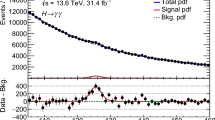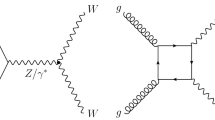Abstract
A method for measuring cross sections at \(e^{+}e^{-}\) colliders for the case where the center-of-mass frame of colliding particles moves in the laboratory frame is proposed. Within this method, the energy dependence of the cross section is extracted from the angular distribution of interaction products. The method applied to the \(e^{+}e^{-}\to n\bar{n}\) process is found to be sensitive. This method provides the possibility of studying the fine structure of the cross section near the threshold at scales much less than the energy spread of the beams used. Similar measurements may be implemented in experiments at the Super Charm-Tau Factory.



Similar content being viewed by others
Notes
This seems quite justified since the method is applicable in a narrow energy range above the production threshold. A substantial contribution of the \(D\) wave will manifest itself in the \(\phi\) asymmetry with respect to the direction of motion of the c.m. frame in the laboratory frame.
REFERENCES
P. Raimondi, Presentation at the 2nd Workshop on SuperB Factory, LNF-INFN, Frascati, March 2006.
Q. Luo and D. Xu, in Proceedings of the 9th International Particle Accelerator Conference IPAC’2018, Vancouver, Canada, 2018, p. MOPML013.
H.-P. Peng, in Proceedings of the Charm2018, Novosibirsk, Russia, May 21–25, 2018.
A. Bondar, Phys. At. Nucl. 76, 1072 (2013).
V. E. Blinov, V. V. Kaminsky, E. B. Levichev, N. Yu. Muchnoi, S. A. Nikitin, I. B. Nikolaev, A. G. Shamov, Yu. A. Tikhonov, and V. N. Zhilich, ICFA Beam Dyn. Newslett. 48, 195 (2009).
B. Aubert, R. Barate, D. Boutigny, F. Couderc, Y. Karyotakis, J. P. Lees, V. Poireau, V. Tisserand, A. Zghiche, E. Grauges, A. Palano, M. Pappagallo, A. Pompili, J. C. Chen, N. D. Qi, G. Rong, et al., Phys. Rev. D 73, 012005 (2006).
R. R. Akhmetshin, A. N. Amirkhanov, A. V. Anisenkov, V. M. Aulchenko, V. Sh. Banzarov, N. S. Bashtovoy, D. E. Berkaev, A. E. Bondar, A. V. Bragin, S. I. Eidelman, D. A. Epifanov, L. B. Epshteyn, A. L. Erofeev, G. V. Fedotovich, S. E. Gayazov, A. A. Grebenuk, et al., Phys. Lett. B 759, 634 (2016).
M. N. Achasov, A. Yu. Barnyakov, K. I. Beloborodov, A. V. Berdyugin, D. E. Berkaev, A. G. Bogdanchikov, A. A. Botov, T. V. Dimova, V. P. Druzhinin, V. B. Golubev, L. V. Kardapoltsev, A. S. Kasaev, A. G. Kharlamov, A. N. Kirpotin, I. A. Koop, A. A. Korol, et al., Phys. Rev. D 90, 112007 (2014).
M. Ablikim, M. N. Achasov, P. Adlarson, S. Ahmed, M. Albrecht, R. Aliberti, A. Amoroso, M. R. An, Q. An, X. H. Bai, Y. Bai, O. Bakina, R. Baldini Ferroli, I. Balossino, Y. Ban, K. Begzsuren, et al., arXiv: 2103.12486.
V. F. Dmitriev and A. I. Milstein, Phys. Lett. B 658, 13 (2007).
J. Haidenbauer, X.-W. Kang, and U.-G. Meißner, Nucl. Phys. A 929, 102 (2014).
A. I. Milstein and S. G. Salnikov, Nucl. Phys. A 966, 54 (2017).
A. I. Milstein and S. G. Salnikov, Nucl. Phys. A 977, 60 (2018).
Author information
Authors and Affiliations
Corresponding authors
Appendix
Appendix
Let us consider the case of \(n\bar{n}\) production under the condition that the \(\bar{n}\) emission angle is measurable in the experiment. The angular distribution of \(\bar{n}\) in the laboratory frame can be determined from the angular distribution and velocity in the c.m. frame.
We denote by \(P_{i}\) the initial-state 4-momentum calculated without allowance for deviations of the initial-particle 4-momenta from the average values. If \(\delta P_{i}\) stands for this deviation, it can be decomposed into the components parallel and orthogonal to the initial 4-momentum \(P_{i}\), \(\delta P_{i}=\delta P_{i||}+\delta P_{i\bot}\). The perturbation \(\delta P_{i}\) can be assumed to be small, while \(\dfrac{P_{i}\delta P_{i||}}{W}\) is the leading term in \(\delta W\). Neglecting the change in the velocity of the c.m. frame, we discard the term \(\dfrac{\delta P_{i\bot}^{2}}{2W}\). This is justified from the point of view of perturbation theory.
Let us consider the Lorentz transformation from the c.m. frame to the laboratory frame (we employ the system of units where the speed of light is equal to unity). Instead of two axes orthogonal to the direction of motion of the c.m. frame, we can retain one axis. We denote by \(T\) the nucleon kinetic energy in the laboratory frame, by \(W\) the invariant mass of the nucleon–antinucleon pair, by \(m_{n}\) the nucleon mass, by \(v\) the velocity of the c.m. frame in the laboratory frame, by \(\alpha\) the angle between the direction of nucleon motion and the \(x\) axis in the laboratory frame (along which the c.m. frame moves), and by \(\omega\) the scattering angle in the c.m. frame with respect to the velocity of the c.m. frame in the laboratory frame. In the nonrelativistic limit, the transformations in question have the form
The upper equation is an equation for \(W\):
From Eq. (A.1), we can calculate the nucleon kinetic energy \(T\) in the laboratory frame as a function of the antineutron emission angle \(\alpha\) and the two-nucleon invariant mass \(W\); that is,
Solving this quadratic equation with respect to \(\sqrt{T}\), we obtain
Requiring that the radicand on the right-hand side of Eq. (A.2) be zero, we obtain Eq. (1), which relates the maximum scattering angle to the invariant mass.
Upon employing reasonable input approximations, we can obtain an equation that makes it possible to determine the dependence \(\dfrac{dN}{dW}\) from the distribution \(\dfrac{dN}{d\cos\alpha}\) (we deliberately use \(\dfrac{dN}{dW}\) to emphasize the need for going over to the cross section via \(\dfrac{d\mathcal{L}}{dW}\)). The conditions underlying these approximations are the following:
•The angular distribution is not taken into consideration.
•The change in the velocity of the c.m. frame because of the deviations of features of primary particles from the average values is disregarded.
•Events in which the invariant mass exceeds \(W^{\star}\) are rejected.
•The angular distribution of product particles in the c.m. frame is isotropic.
•Radiative corrections are neglected.
In this approximation, the angular distribution in the laboratory frame with respect to the direction of the velocity of the c.m. frame can be represented in the form
Rights and permissions
About this article
Cite this article
Bobrov, A.V., Bondar, A.E. Measurement of the \({e^{+}e^{-}\to n\bar{n}}\) Cross Section near the Threshold with a High Energy Resolution. Phys. Atom. Nuclei 86, 238–245 (2023). https://doi.org/10.1134/S1063778823030043
Received:
Revised:
Accepted:
Published:
Issue Date:
DOI: https://doi.org/10.1134/S1063778823030043




